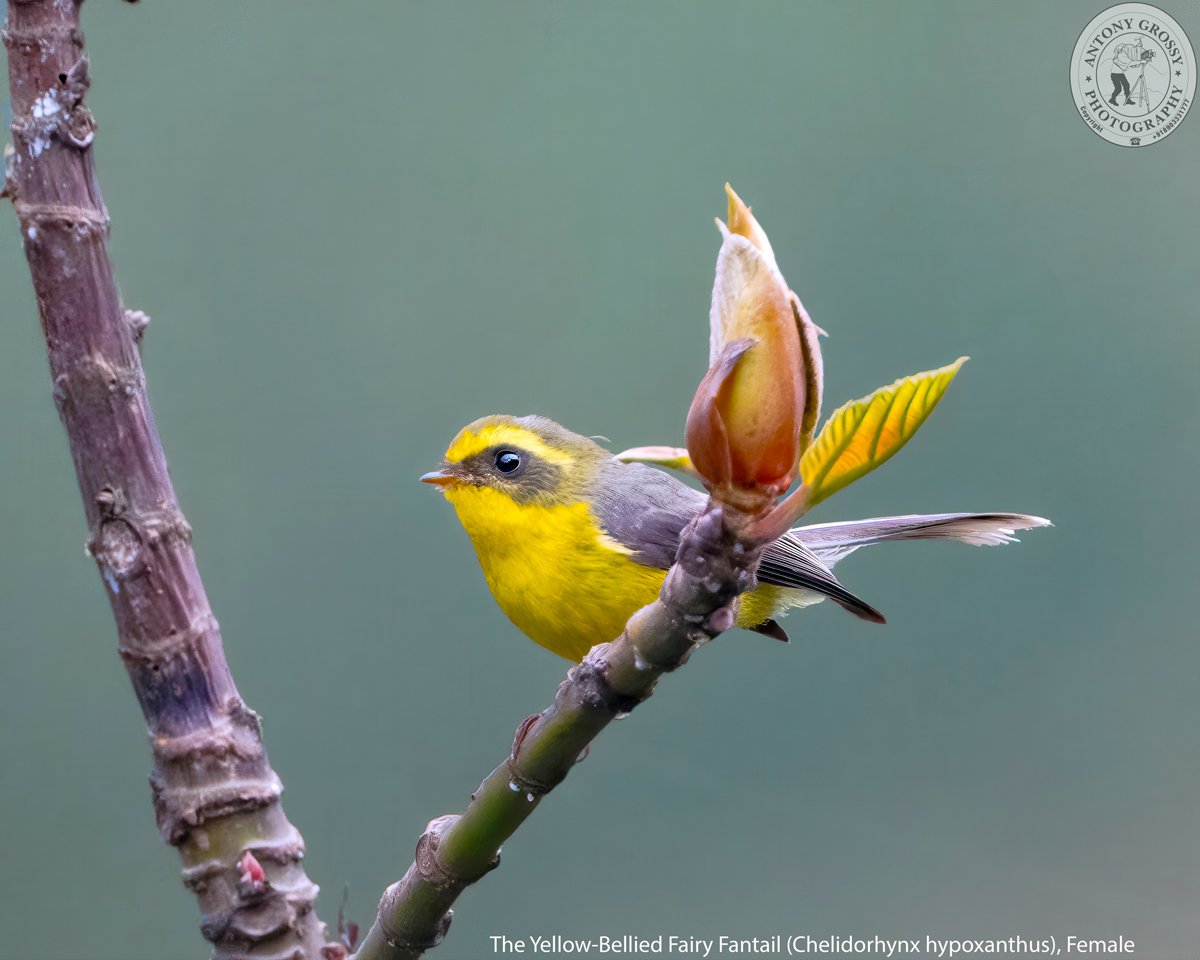

|
 |
| The Pixie of Mountainous Forests – The Yellow-Bellied Fairy Fantail, Female |
|
The Yellow-Bellied Fairy Fantail is a small, active little bird with a bright yellow belly, black eye-stripe, white wing-bar, and a black tail tipped with white fan-like tail. Most common in foothill and submontane broadleaf forests in the Indian subcontinent, Himalayas, and parts of Southeast Asia, where it forages energetically and acrobatically in the middle and lower levels, often with Fulvettas, Warblers, and other small passerines in mixed-species foraging flocks. Very similar in shape to fantails but much smaller, and actually more closely related to Tit. . . . . . . . . . . . . . . .. .. …. ……. . .. … …… ………………………. ………….. ……………….. .. …. …. ……….. … …. ……….. … …. ………… ………….. ………… ………… ….. ………. …………. …….. ……………. …… …. …. ……….. … …. ……….. .. ………… ….. ………. …………. …….. …… The Yellow-Bellied Fairy Fantail also called the Yellow-Bellied Fantail is a highly active bright yellow bellied bird measuring 11.5 to 12.5 cms in length and weighing about 8 gms. The Male has upperparts dark greyish-olive, forehead and supercilium yellow, broad black patch from lores on to ear-coverts; upperwing greyish-olive, greater upperwing-coverts tipped whitish; underparts bright yellow; tail brown, rectrices with conspicuous white tips and shafts; iris dark brown; upper mandible dark brown, lower mandible yellowish-brown; legs brown. Female is like male, except that patch from lores through ear-coverts is dark olive. Immature is like female, but forehead lacks yellow, back greyer, supercilium and underparts dull pale yellow. . . . . . . . . . . . . . . .. .. …. ……. . .. … …… ………………………. ………….. ……………….. .. …. …. ……….. … …. ……….. … …. ………… ………….. ………… ………… ….. ………. …………. …….. ……………. …… …. …. ……….. … …. ……….. .. ………… ….. ………. …………. …….. …… The Yellow-Bellied Fairy Fantail is found in the Indian subcontinent, the Himalayas, and portions of South East Asia including Thailand, Vietnam, and Myanmar. It is found mostly in various types of forest and secondary jungle, but prefers moist evergreen broadleaf forest; in breeding season, mostly mixed coniferous and birch or rhododendron forests. Frequents lower canopy and taller shrubs, often at forest edge. In summer up to tree-line, generally to 3600 mtrs. An altitudinal migrant; that moves to lower elevations in non-breeding season (Oct to Mar). Forms small flocks on passage. . . . . . . . . . . . . . . .. .. …. ……. . .. … …… ………………………. ………….. ……………….. .. …. …. ……….. … …. ……….. … …. ………… ………….. ………… ………… ….. ………. …………. …….. ……………. …… …. …. ……….. … …. ……….. .. ………… ….. ………. …………. …….. …… Its diet consists mostly small flying insects, particularly flies. This bird is also known for its acrobatic flycatching behaviour and preference for lower and middle levels of forests. Prey flushed by fluttering among foliage, and captured in aerobatic sallies; also hover-gleans. Forages mainly in outer foliage of low bushes to canopy of tall trees 30 mtrs or more above ground, occasionally coming to ground. Joins mixed parties of small insectivorous birds, particularly in non-breeding season. . . . . . . . . . . . . . . .. .. …. ……. . .. … …… ………………………. ………….. ……………….. .. …. …. ……….. … …. ……….. … …. ………… ………….. ………… ………… ….. ………. …………. …….. ……………. …… …. …. ……….. … …. ……….. .. ………… ….. ………. …………. …….. …… Its Song is a series of high a series of thin sewit sweeit and tit or tsit notes followed by high-pitched trill; call a thin high tseep, repeated and then interspersed with twitters and trills. Call is often repeated at length, akin to a song, but much simpler, a series of high tsip notes. ………… ….. ………. …… ………….. ………… ………… …. … … …… ………….. ………… ………… ….. ………………….. … ………… ….. ………. …… ………….. …………………….. … ………… ….. ………. …… ………….. ………… ………… …. … ……… …… ……….. …… ………….. ………… ………… Description Credit Birds of the World (The Cornell Lab), Oiseaux, Birda, Animalia, Nepal Desk, Ogaclicks, Birds of India | Bird World, Bird Count India & Wiki. |
  |
|
|

























































































































































































































































































































































































































































































































































